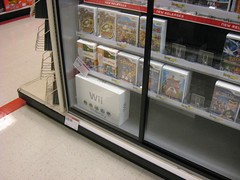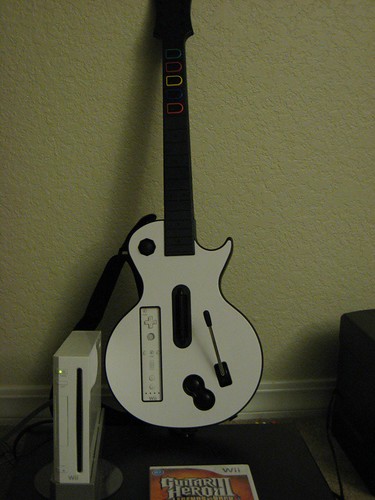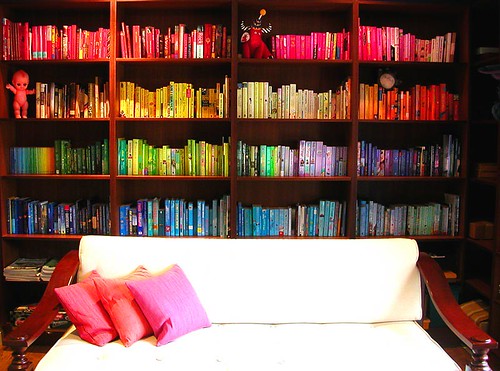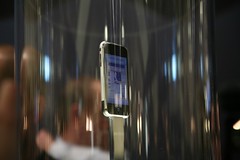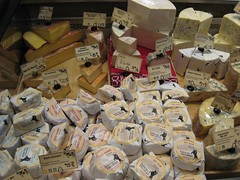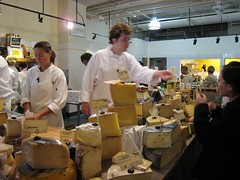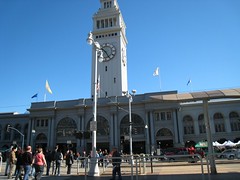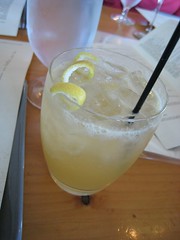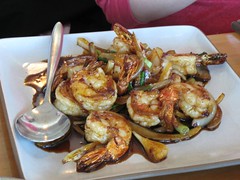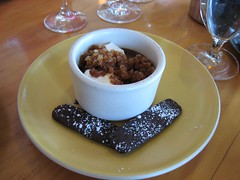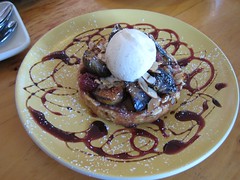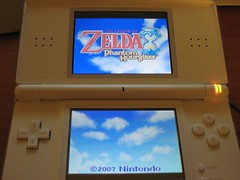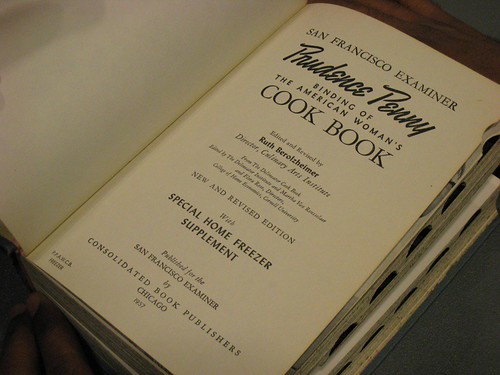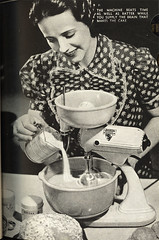-
Can you imagine a 400 year old clam? That's a long time to be filtering food.
-
How to make a Darth Vader/Anakin Skywalker Pop-Up Mask
-
An awesome steampunk Flux Capicitor
October 2007 Archives
An earthquake just shook us up in the Bay Area, and this one is relatively close by, according to the USGS, centered about 9 miles NE of San Jose City Hall and 8 miles NNE of Alum Rock, which puts it out in the middle of nowhere, between San Jose and Tracy. It shook for about two minutes, and USGS is reporting it as 5.6 on the Richter scale along the Calaveras fault.
Last night, we saw David Sedaris at the San Jose Center for Performing Arts. This was the second time that I have done photography in this particular venue, the first time just a few months ago shooting the FanimeCon 2007 Masquerade.
The situation was different for FanimeCon, as I had received a press pass, and was sitting smack in the middle of the second row, right behind the judges and a row of press -- my obstacles for shooting were the judges and the various objects on the stage that could obstruct my shot. However, an even larger problem during the masquerade was the lighting. When you're sitting 10 feet away from the stage, you're flooded with light, even if all the other lights in the theater (save the emergency lights) are off. Because there was so much light available, what became more important was the shutter speed -- if it was too fast there wouldn't be enough light, and my pictures would have been underexposed, and if it was too long, the picture would be overexposed from all the light flooding into the camera. I was able to get some fantastic pictures at ISO 50 after playing around with the settings a bit, which I was quite happy with.
For David Sedaris, our tickets landed us in the twenty-third row of the theater, underneath the balcony overhang, and only a few rows away from the absolute rear of the theater. We were however, in the center directly facing the podium and David Sedaris. Not knowing where we would be seated, I had thought ahead, and brought my EOS 20D and the 70-200 f/2.8 L IS to give me maximum range. You won't ever hear me say anything bad about this lens or this camera body, because they are fantastic pieces of equipment, and they never fail to impress me. Before he comes on stage, they've turned off all the lights, and centered the spotlight on the podium. We're sitting somewhere in the ballpark of 70 - 80 feet away from David Sedaris, and from there, you can't really even make out his face. Part of that is due to the lights they're using in the theater, it gives a pinkish-red glow to one side of his face and his hair. It reminds me of those warming lamps you used to see at all the fastfood joints before they switched to microwaves. Indoor shots in near complete darkness do not fare well, even with a large aperture lens, so I took a few test shots, made some adjustments, and discovered that the lighting on the stage is actually so bright that I had no problems shooting at ISO 200 and 400. I took less shots than I usually do, partly because I'm just too mesmerized by his stories and wit, and partly because the screen of the LCD is just so distractingly bright that I switched it off after completing my test shots. Usually even after I feel that I've got the correct settings, I still check the LCD after taking the shot, so If this photoshoot could be parodied by Star Wars, it might go something like this:
"Mike! You've switched off your LCD display. What's wrong?"
"Nothing, I'm alright."
In Star Wars, Luke manages to make the one-in-a-million shot resulting in a grand explosion, whereas my shots just result in my happiness of managing to get a nice clear photo.


At the San Jose Center for Performing Arts, David Sedaris read some selections that
1) Wouldn't be aired on NPR for use of strong language about a houseguest he had in France.
2) Would be in his next book about a neighbor in New York City.
3) Would run in the New Yorker (about his plane trips in Business Elite Class).
4) Could be found in his diary (about life in Buffalo, London and Tokyo).
Afterwards, he recommended "The Easter Parade" by Richard Yates (apparently at each reading he does, he recommends a book by another author, and encourages people to pick up the recommended book before buying one of his own).
Some questions I can remember him answering:
- How's David's brother doing?
David's brother is doing well, and adjusting to life as a father. His brother has matured some, and he misses how his brother used to hide meat in his luggage, and smear the meat across something inside. His luggage always came back with dozens of FAA warning labels.
- Is being famous everything he hoped it would be?
Absolutely. David Sedaris loves hearing his name being announced before a reading. Since he tends to do book signings before his reading, if he doesn't someone introducing him, he'll pick out a person, and hand some cash to introduce him to the crowd. In the case of one his previous shows, he picked a 16-year old girl, gave her $20 and said "Okay, go out there, introduce yourself, tell them your age, and then introduce me". There's nothing quite like being on stage and hearing applause and cheering. Sedaris adds "Can you imagine being 16 years old, and having 2900 people applaud you? I've probably just ruined her life."
- In one of his more recent book signings, another high school girl asked him for a suggestion of what line she should use to write in yearbooks. Sedaris' reply? "I'll sleep with anyone." After realizing that the older woman standing behind the girl was her mother, Sedaris changed his mind about the line and suggested to the girl instead "I'll suck on anything."
- Someone asked him what other books has he recommended in the past, and there have been a lot. He tends toward the sad stories more, and in regards to sad fiction stories, he feels they are more disposable than sad real-life stories.
November is National Novel Writing Month, so I'm going to make the attempt once again to write a novel of 50,000 words or more.
-
The hilarious thing about the video is watching the iPod bounce up and down in the cup holder from the vibrations put out by this sound machine.
-
I can't believe FEMA staged a fake news conference.
During Comic Con this year, we had a chance to preview the Pixar Short Films Collection Volume 1. This DVD includes the following shorts:
- The Adventures of Andre and Wally B. (1984)
- Luxo Jr. (1986)
- Red's Dream (1987)
- Tin Toy (1988)
- Knick Knack (1989)
- Geri's Game (1997)
- For the Birds (2001)
- Mike's New Car (2002)
- Boundin' (2003)
- Jack-Jack Attack (2005)
- One Man Band (2006)
- Mater and the Ghostlight (2006)
- Lifted (2007)
A majority of these shorts are already available included with previously released Pixar DVDs, but this DVD does include audio commentary on the shorts, as well as some animation tests and a behind-the-scenes featurette.
 When I was growing up, carbonated beverages were a special treat. We'd get them when we ate out or got them as part of kids meals, but my mother never bought them in flats from CostCo. Even now as an adult, I don't have them all that often, but when I do drink them, I am all too aware that what I'm drinking is mostly corn syrup, diluted just enough with water so that it remains a liquid, which is why I find Diet Coke Plus so intriguing. First of all, Diet Coke Plus is Diet Coke -- it tastes nothing like Coke, but it's more guilt free because instead of odious amounts of sugar, it uses a sugar substitute. Secondly, Diet Coke Plus is essentially Diet Coke with vitamins. It's like the excuse ultimate drink for people who want to indulge in drinking unhealthy soft drinks -- not only can they say it's sugar-free, but they can also say they're getting their vitamins too. Seeing how successful energy drinks are, I suspect that this is one Coke variation that will likely stick around.
When I was growing up, carbonated beverages were a special treat. We'd get them when we ate out or got them as part of kids meals, but my mother never bought them in flats from CostCo. Even now as an adult, I don't have them all that often, but when I do drink them, I am all too aware that what I'm drinking is mostly corn syrup, diluted just enough with water so that it remains a liquid, which is why I find Diet Coke Plus so intriguing. First of all, Diet Coke Plus is Diet Coke -- it tastes nothing like Coke, but it's more guilt free because instead of odious amounts of sugar, it uses a sugar substitute. Secondly, Diet Coke Plus is essentially Diet Coke with vitamins. It's like the excuse ultimate drink for people who want to indulge in drinking unhealthy soft drinks -- not only can they say it's sugar-free, but they can also say they're getting their vitamins too. Seeing how successful energy drinks are, I suspect that this is one Coke variation that will likely stick around.
-
A list of the warnings and evacuation notices for fires
-
Clive Barker on Art and Games
-
Greyfang, a Lego Space Cruiser
-
Best Week Ever presents a Harry Potter themed cover for People Magazine
I think the design of these bowls is just brilliant -- they're friendly and inviting, and will probably end up in a hipster restaurant near you. They were designed by Jensen and Holbaek for Eva Solo


-
A PDF comic intro to Japanese Manga in the United States
-
The five foods that switching to organic make the biggest impact with.
"I lived on the Moon" by Yannick Puig (june2007)
A wonderful CGI short set to the music of the Kwoon's "I Lived On The Moon".
 . Apple has released a "soundtrack" for the songs used in the Guitar Hero series of games. I put "soundtrack" in quotes, as it's not a reall soundtrack album per-se, but rather a compilation listing of all the songs used in the Guitar Hero games, and because you're buying these tracks individually, you're paying the full 99 cents per song. The complete set of songs amounts to 75 songs and a total cost of 74.75, and Apple has broken it down into 3 smaller compilation sets, priced at 24.75 apiece and including 25 songs per album.
. Apple has released a "soundtrack" for the songs used in the Guitar Hero series of games. I put "soundtrack" in quotes, as it's not a reall soundtrack album per-se, but rather a compilation listing of all the songs used in the Guitar Hero games, and because you're buying these tracks individually, you're paying the full 99 cents per song. The complete set of songs amounts to 75 songs and a total cost of 74.75, and Apple has broken it down into 3 smaller compilation sets, priced at 24.75 apiece and including 25 songs per album.
I don't know about you, but after busting my fingers trying to pass some of these songs in the first place, I have very little desire to hear them again. Ever.
If you've ever watched the anime Naruto, you know that Naruto loves ramen (and is occasionally bribed by his teachers with promises of all-you-can-eat ramen). A promotional event for the release of Naruto: Clash of the Ninja Revolution at the Nintendo World Store at Rockefelller Center in New York City will have as part of its activities a Ramen eating contest, sponsored by Major League Eating. As part of the competition, contestants will be required to use chopsticks to consume the ramen, to keep with the traditional way of eating ramen.
I've been to a ramen eating competition once. It was a torturous affair for the contestants, dealing with hot ramen broth (as the broth was required to finish in order to count) and undercooked noodles, so I'm curious as to see how the pros approach it. I'd so be there (watching) if I was in NYC.
Press Release in the extended.
 A visit to Prada's website reveals a short movie (accessed by the Japanese character for film on the top of the page) of Appleseed: Ex Machina, and along with clips of the film, also reveals a couple of clothing designs by Prada used within the film.
A visit to Prada's website reveals a short movie (accessed by the Japanese character for film on the top of the page) of Appleseed: Ex Machina, and along with clips of the film, also reveals a couple of clothing designs by Prada used within the film.
Appleseed: Ex Machina has chosen to go with a very CG looking art style, one that could be classified photorealistic anime, much like the Final Fantasy series.

-
Hikaru Dorodango -- rolling dirt into a shiny sphere.
This weekend, I went to the city, and when I came back home, I couldn't find my headset for my iPhone. Since the headphones for the iPhone have the nice feature of a) being wired and b) having a microphone, and me fearing that I had lost the headset walking around Valencia, I started to look into alternative headsets. The replacement from Apple for the same headset that you received in the iPhone box is 29.00. Ouch. The Apple Store carries 10 other headsets. Of those headsets, 8 of them are Bluetooth wireless headsets, one is a headset/headphone adapter, and the other one is wired, but discontinued. Considering that the iPhone has only been out for 4 months, having a product be discontinued that quickly isn't a good sign. Headsets range from 29.00 (the Apple headset) all the way up to 349.00 for the almost-more-expensive-than-your-iPhone-and-probably-overpriced Bang and Olufsen Earset 2 (Right).
I've never liked Bluetooth headsets. Yes, it's wonderful that it's wireless, but isn't the whole point of having headsets to get away from all the potential radiation that's emitted by wireless devices? 29 dollars didn't seem so bad for a new pair of headphones, but the principle of the matter bothered me, because my experience with the iPhone headphones was that while they were okay, they didn't feel like they were $29 headphones. $9 maybe, $19 tops, and given the other options out there for a replacement, my choice of replacement became much harder.
Interestingly enough, Apple also sells the headphones that are bundled with the iPod for the same cost ($29), and I have several pairs of those owing to the different iPods I've purchased over the years, and the cost of those never quite added up either. Take for instance the iPod Shuffle -- $79 buys you a shuffle, a shuffle dock ($29), and headphones ($29). A quick calculation means that the iPod shuffle is worth approximately $21 -- less than either of the dock or the headphones. If you need extra accessories, you might as well purchase a new shuffle!
Luckily, I found my headset (caught on the seatbelt), and didn't have to think about it anymore, but it started me thinking along the lines of just how much stuff is packed into the iPhone box: iPhone USB Cable, Dock, Power Adapter ($49) and iPhone Headset ($29) - that's $78 dollars worth of accessories if you want an extra set or need a replacement.
My old Nokia, in contrast is stupidly cheap -- $5 for a wired headset, and $5 for a power adapter, online I can find it for half that much, and going to a retail cell phone store store I might be paying double that, but I can deal with that much if I lose something or a need a charger when I'm travelling -- but I find it amazing that they can get away with charging so much for items that probably only cost a few dollars to make in China. It almost makes me glad that the iPhone doesn't have replacement batteries -- how much would Apple charge for those?
For months now, I've been plagued with an error every time I posted to this blog, and while I probably should have done this a month ago when they released Movable Type 4.01, I've finally upgraded my installation from 4.0 to 4.01.
In addition, I've installed the fabulous iMT plugin, which allows me to blog and manage comments from my iPhone.
This afternoon, Apple announced their earnings for this past quarter, which ended at the end of September. For this quarter, they sold 2.1 million Macs, 10.1 million iPods, and 1.1 million iPhones, and ended with a quarterly profit of $904 million. At the end of this week, Apple will release the latest revision of their operating system Mac OS X 10.5 Leopard, and pre-orders are already double what they were for the previous version.
Looking back at this year, it's been a long, but very successful year for Apple. It was only in January that Apple introduced the iPhone at MacWorld, and it was last October when the transition to Intel architecture was complete. Apple introduced a bunch of new products, and brought touch-screen to a new generation of products, with the iPhone and the iPod Touch. While I'm not particularly fond of their design for the new iPod nano, the functionality of the device is still enough to put it at the top of many wishlists for the holiday season.
I was listening to the conference call after the earnings announcement, and there was a couple of surprising comments afterwards; the first is that they aren't moving forward with Circuit City, and focusing more on Best Buy, and the second is that Apple estimates that up to 250,000 of the iPhones sold were purchased for the purpose of being unlocked. Japan is still the most challenging market for Apple products, and they are planning a new Apple Store in Beijing next summer.
One of the things I've felt that Apple has really succeeded in is the Apple Store. The Apple Store serves three main purposes: to demonstrate their products, to support their products, and to sell their products. The average Apple Store brings in approximately 6.6 million in revenue this past quarter, which was an increase of 1 million over the results of the previous year for the same quarter. The next quarter ends at December, and Apple has high hopes, as they believe that this is the best product lineup in Apple's history.

Wacom has announced (in Europe anyways) the Cintiq 12WX, a widescreen 12 inch Cintiq, which is basically a Wacom Intuous 3 6x11 with an integrated 12 inch widescreen LCD monitor.
Last year, the powers that be decided that they would downsize E3 and make it exclusively industry only (which E3 was already) and create an publicly accessible videogame convention called "E for All". The first ever "E for All" was this weekend, and you probably didn't hear much about it because apparently, "E for All" was a bomb. Not "Da Bomb" but "a bomb". Funny how one letter and choice capitalization makes such a big difference.
Sticking a videogame convention in Los Angeles in the middle of October and charging $90 for a four-day pass is likely not going to bring in that many people -- in fact their attendance count is estimated to be 18,000 over the course of the entire 4-day show. While the press release was intended to put a positive spin on these numbers, their original expected estimate for attendance was between 20,000 and 30,000 people. Previously, they had announced that in 2008, E for All will move to the last weekend in August and compete directly with PAX (Penny Arcade Expo) for gamer attendees. "E For All" has since withdrawn their August 2008 date after a scathing interview from the Penny Arcade folks, which makes me wonder if this E for All will be the first and last.
Haruhi Eva:
Haruhi Stole the Precious Thing:
-
A story from the CBC about videogames in China
This morning, Sony officially announced the release of the 40GB Playstation 3 in the United States, and a price drop for the 80GB Playstation 3. The 80GB PS3 drops down to $499 from the previous price of $599 -- which it was introduced at in early August of this year.
The new $399 40GB PS3 includes a bevy of stripped down features such as no memory card reader, two USB ports instead of four, and no backwards compatibility with PS2 games, and includes a Blu-Ray version of Spider-Man 3. The obvious angle here is that Sony is attempting to market this as a movie player rather than a video game system (as everyone knows how unpopular of a game system the PS3 is, but is apparently unaware of how bad a movie Spider-Man 3 is)
Pearl Jam's Even Flow on Guitar Hero 3:
Announced at GenCon earlier this year, the 4th Edition of Dungeons and Dragons will include a virtual tabletop program where you can model your character in 3D and move him across a virtual map and roll virtual dice. I find it interesting that the characters are modeled in very static poses (to reinforce that they are miniatures) and slide across the map while rolling of the dice utilize a physics engine so they interact with the tabletop in a very realistic way. I also find it intriguing that their map program, while providing light sources for the player chose not to include any walls. I almost feel as though they're reinventing this product again, considering that Baldur's Gate did a pretty good job of including a very good scenario editor.
In the games industry, EA has this reputation of buying independent game companies, and then shutting them down. A look at their EA's former studios has some rather grim statistics for their acquisitions:
- Origin Systems (Ultima, Wing Commander) - EA acquired in 1992, closed in 2004.
- Bullfrog Productions - acquired in 1995, closed in 2001.
- EA Baltimore - acquired in 1996, closed in 2000
- EA Seattle (Manley & Associates) - acquired in 1996, closed in 2001.
- Maxis - acquired in 1997, moved into EA Redwood City in 2004.
- Westwood Studios - acquired in 1998, shutdown in 2003.
- EA Pacific (formerly Westwood Pacific) - acquired in 1998, closed in 2003.
- Kesmai (aka Gamestorm) - acquired in 1999, closed in 2001.
- DICE Canada - acquired October 2, 2006, closed hours later.
Now they've acquired Pandemic and BioWare. Pandemic (Dark Reign 2, Star Wars Battlefront, Full Spectrum Warrior, Destroy All Humans) and BioWare (Baldur's Gate, Star Wars: Knights of the Old Republic) are both owned by VG Holding Corp, which is the real acquisition by EA, but I highly suspect that EA's goal is geared more towards capturing the intellectual property these companies own than expanding their offices to where Pandemic and BioWare located. Most of these closures happen slowly over a couple of years as products in progress finish, and slowly the office is downsized until there is no one left.
With Halloween coming up right around the corner, one of the MTV interns
wants some help on building a Halo 3 Master Chief costume.
-
Because before shacking up with Microsoft and making Halo, Bungie made other games.
-
I love the look of this watch, just wish itt wasn't $120.
In the Mission District, near Delores Park is Bi-Rite Creamery. Bi-Rite Creamery is a small ice cream shop; they make the ice cream in the back, and there's a small countertop with stools for patrons, but the shop is probably half the size of your living room. They have a small selection of ice cream standards, but they also carry flavors like Strawberry Balsamic, Honey Lavender and Salted Caramel. While it is possible to get scoops and sundaes there, we opted for the pre-packaged pints to bring back home. Prepared in small batches, these artisans use local organic milk to create their ice cream, and the result is a smoothly textured and richly flavorful ice cream.
Located inside the Ferry Building is a small avenue filled with small boutique shops and restaurants that are often specialty stores. One of the stores within is a cheese shop callled Cowgirl Creamery.
Cowgirl Creamery is a locally made cheese (in Point Reyes) which uses natural, organic milk. In addition to selling their cheese inside the Ferry Building, Cowgirl Creamery Cheeses can be found in many local markets and restaurants, but for the full cheese shop experience, I highly recommend visiting the store; filled with a dazzling array of cheeses and other food products, the sales people are more than happy to help out in selecting a cheese that fits your tastes and feeding you samples of their wonderful cheeses.
For someone who lives in the Bay Area, I don't travel to the city all that often, and I probably don't give it enough props for what the city offers. I often say things like "Why do I need to go all the up to city to have sushi when I have sushi restaurants right here on the Peninsula that are equally as good?" or my favorite: "I can't live without my car, and San Francisco punishes you for owning one". Indeed, without a car, life in San Francisco is a lot easier. Muni and BART will get you where you need to go within the city, without the horrors of driving and parking.
Saturday mornings in SF in the fall are much quieter than the summertime. The tourists are gone, and what remains are the locals heading to the Farmer's Market at the Ferry Building. I've been to the Ferry Building only a few times since they've renovated it, with most of my memories are from my days at Berkeley, where the buildings beside the Pier were largely vacant and decrepit. Seeing a lively San Francisco's Ferry Building again on a beautiful autumn day was in stark contrast to the paint-peeled abandoned buildings and parking lots that used to be used as overflow for Pier 39 in my undergraduate days.
It was at the Ferry Building that we had lunch at the Slanted Door, a Vietnamese-fusion restaurant headed by chef Charles Phan. Slanted Door separates itself from other Vietnamese-fusion restaurants with the use of local and organic ingredients in their cuisine. At 11 in the morning on a Saturday, we were the third party in the door, and we were seated quickly after queuing outside for half an hour. Those behind us, may not have been so lucky, as a good majority of the tables were reserved, and the waiting area and the bar quickly filled up.
The restaurant is family style, and the food is meant to be shared, even if the primitive, hunger-starved portion of your brain wants to selfishly hoard it all because it all tastes so good. Their bar, I am told, holds a rather impressive selection of wine and spirits, and I could not leave without sampling a cocktail. I chose the sweet and citrus French 75, made with Grower Cognac and Tissot Crémant du Jura, fresh lemon and served on the rocks ($10). meta ordered a Blue Bottle organic Wotona french press coffee ($4) to go along with the Summer on the Danube (Prosecco with a splash of Nikolaihof biodynamic elderflower syrup - $10). These drink of course, were not nearly half as interesting as the table show given by littlestar's Heavenly Flower tea, which blossomed as it released its flavor into the hot water.
We started off with an order of crispy vegetarian imperial rolls and Manila clams. Served with lettuce, mint leaves, and a dipping sauce, the Imperial rolls were filled with taro root, cabbage and glass noodles. They were perfect in their crispness, and wrapped with the leaves and dunked in the dipping sauce, they proved to be challenging to eat without falling apart, even with the amount of skill our party had with chopsticks. The Manila clams were served with thai basil, crispy pork belly and fresh chilies in a shallow ceramic dish, and the restaurant was conscientious enough to provide us with a dish to dispose of the clamshells.
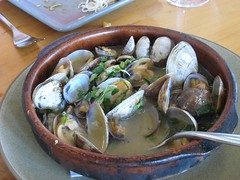

One of the things that I notice about eating well-prepared organic foods is that you can taste the difference between organic and conventional; organics have a little more flavor to them, and this is especially more apparent in the meats more than anything else. In eating the Grilled Niman Ranch double-cut pork chops with ginger-soy-shallot sauce and crispy potatoes, one is reminded that this is exactly what pork should taste like.
For the seafood portion of our lunch, we had cellophane noodles with fresh dungeness crab meat, and caramelized tiger prawns with garlic, onions and chili sauce. These two simples dishes are staples for Vietnamese restaurants like the Slanted Door, and they did not disappoint; the taste of the crab accompanied the texture of the noodles well, and the tiger prawns were big and juicy.
The Slanted Door has a large selection of desserts on their menu, and we indulged ourselves with the following: Warm chocolate cake, Warm fig-goat cheese tart, and the E. Guittard dark chocolate pot de crème. All were beautiful presented, and quite tasty. The dark chocolate pot was rich and chocolately, and the warm chocolate cake was light and fluffy without losing any of the richness. Small scoops of ice cream accompany the warm desserts, to contrast the warm with cold. Vanilla bean with the fig goat cheese tart, and coconut with the warm chocolate cake. The fig and goat cheese tart was probably my favorite of the three, owing to the crispy tart crust and the sweetness of the figs.
The Slanted Door: Food: 5/5, Service 4/5.
-
Vivienne Westwood on consumerism and fashion
which borrows heavily from the work of kozyndan and uses a song previously used by Apple for their iMac:
Apparently, the Nintendo Wii has a new SKU, just in time for the holiday shopping season. The new Wii SKU is 045496880088, and it lists for 289.99 CAD. (Isn't this $10CAD higher than last year's price?)
If you recall, this was the first step in a hypothetical situation in which Nintendo raised the price on the Wii.
However, this is probably not the price hike that I predicted, as the new Wii SKU most likely includes the new Wii Remote Jacket, which current Wii owners can receive from Nintendo (for free).
I started playing Zelda: Phantom Hourglass this this evening. In as much as Legend of Zelda: Twilight Princess on the Wii took advantage of the unique controller configuration of the Wii, Phantom Hourglass does the same with the stylus and touchscreen on the Nintendo DS. Instead of using the standard crosspad and buttons, the stylus becomes the way that Link moves and attacks on the screen. In addition, the use of the stylus allows one to jot down notes on the map,
The attack methods for the game seem very similar to that of Okami, in which a slashing motion of the stylus results in a slash, and a circular motion triggers a spin attack. Rolling, so far seems to be the most difficult maneuver in this game, requiring a little circle at the edge of the screen.
John Hodgman explains how the Canadian dollar has reached dollar parity with the American dollar.
-
The iPod index. Hong Kong narrowly beats out the U.S. for the cheapest place to buy an iPod.
This video needs a little explanation. First, there was "Marisa stole the Precious Thing", using sound samples from a space shooter called Touhou:
Then someone decided to make a Mario version using Mario 64.
I like the original one better.
In the aftermath of Romeapalooza '98, we discovered this somewhat baffling tome representing itself as the 1957 edition of "The American Woman's Cookbook", featuring odd recipes such as Chicken Mousse, Ham Mousse, and Cottage Cheese and Peanut Loaf. Because I have a fascination for things old and strange, I took it upon myself to trace the history off this strange book.
Originally written in 1934, the American Woman's Cookbook was edited and revised by Ruth Berolzheimer, the Director of the Culinary Arts Institute from the Delineator Cookbook. It was then reprinted many times over the next 40 years, and quite honestly, save a few odd recipes here and there, it seems to be a very capable cookbook. In the 1945 edition that I borrowed, the book includes a section on Wartime Cooking which includes helpful advice such as "Use the More Perishable Meats" and "Eggs are Valuable Food".
The book is somewhat more broad-reaching than modern cookbooks in the typical American home, as it contains a section on how to cook Frogs and Turtles. What I love most however, are the photographs used within the book to illustrate the foods and the preparation involved. Some of the captions include quotes form the "Irradiated Evaporated Milk Institute" and the "Institute of American Poultry Industry".
-
The Stop Playing Games Matrix (a decision tree)
-
This is a complete walkthrough of the game, don't watch it if you don't want to be spoiled.
-
Thai dish sets off terrorism alert in London.
-
Fashion inspired by Star Wars. Includes the Boba Fett hoodie.
-
Zupon using his college apartment as an underground restaurant specializing in molecular gastronomy.
In just three years, Nintendo has managed to sell 50 million Nintendo DS', including both the original and the lite version of the portable console system. Even with the release of the DS Lite last year in the U.S., there was never a widescale shortage of Nintendo DS Lites (except at Christmastime) as there was in Japan, where a DS Lite was nearly impossible to find 6 months after release (we found some, but we could not have done it without the help of our Japanese friend).
Nintendo has said on the record that they will not be able to meet demand for the Wii in the United States in time for Christmas. Lately, stores have been making available more Wiis, and every now and then, Amazon will have the Nintendo Wii in stock.
Some people say that system shortages are created by the manufacturer; surely if the manufacturer wanted to do so, they could ramp up their production to meet demand, and as the Wii shortage quickly approaches a year, it seems that this shortage is more a product of corporate greed than anything else. I disagree with this conspiracy theory, and here's why: Nintendo has managed to sell over 10.7 million Wiis worldwide in the last 10 months, with approximately half of all Wiis going to North America. A quarter of the Wiis end up in Japan, and the other Wiis end up all over the rest of the world. Compare that with their sales and manufacturing for the Nintendo GameCube: 21.63 million over a timespan of 6 years. The complexity in building a Wii is not all that different from building a GameCube, and assuming the same facilities, the GameCube factories were pumping them out at a rate of approximately 300,000 per month. Manufacturing rates for a Wii are more than triple that, so it seems to me that they're making them as fast as they can. Even if we look at Nintendo's Golden Age with the Famicom and the NES, they sold 60 million gaming systems over a span of 12 years, an average production rate of 5 million console units a year -- the Wii has surpassed that number by two-fold.
Yes, the Wii is a great system. Everyone that has one loves it, and it gets everyone involved with gaming. That being said, the components behind a Wii console system a year ago cost about $160 dollars, meaning that a good $40 or $50 dollar profit was being made on each one sold. A year later, production costs must be cheaper, which means the profit margin for Nintendo must be much higher, possibly what they were getting a year ago. Keep in mind that Nintendo is still getting full retail price on this video game console system. Compare that with the pricing on Nintendo's GameCube, which was never a market leader despite it's low cost:
- November 18, 2001: GameCube Releases at $199.99.
- May 13, 2002: GameCube Price Drops to $149.99
- September 24, 2003: GameCube drops to $99.99
The first price cut came at nearly 7 months after the release, while the second price cut occurred 22 months after release. We are now at 10 months post release, and because demand for the Wii is good, there's very little chance of a price cut. Nintendo's main competitors, Sony and Microsoft have not gotten into a pricing war due to the difference in costs of the various systems, and the lack of profitability in the original relase of these systems. It was estimated that Sony was losing about $200-300 per unit sold, while Microsoft was losing 125 - 225.
Microsoft XBox 360:
- November 22, 2005: 360 Core $299 (rumored to be discontinued soon), 360 Premium $399
- Aprill 29, 2007: 360 Elite $479
Sony's Playstation 3:
- November 17, 2006: Sony Playstation 3 (20GB) $499, Sony Playstation 3 (60GB) $599.
- July 8, 2007: Sony Playstation 3 (60GB) $499,
- August 6, 2007: Sony Playstation 3 (80GB) $599. (20 GB & 60 GB Discontinued)
This seventh generation of game systems has the Wii, in a state of shortage, which has been profitable from day one, the Xbox360 which was released first, and maybe finally starting to hit the break even point, and we have the Sony Playstation 3, which continues to lose money.
I thought by now that the Nintendo Wii would have been widely available a few months ago. I even revised my original optimistic "by May/June" to "August/September" . Now, as far as estimates go, I was a little off, but not nearly as off as market analysts who predicted "March 2007" for the Wii, an not nearly as pessimistic as the analyst predicting No Wiis until 2009.
Is there profitability involved? Quite certainly. To enter into manufacturing agreements with other factories costs money, and a new facility would be a huge capital expenditure, and demand for the system is still good, and at the moment, there is no substitute for the Wii and their games. People buy game systems for the games, and while a price increase in a game system has never happened before (due to declining manufacturing costs and the need to stay competitive), Nintendo has a unique product with a lock on licensed characters and I'm going to make a bold, somewhat crazy prediction now: Nintendo will raise the price on the Wii in the U.S.. Here's my reasoning: the U.S. Dollar has reached parity with the Canadian Dollar, and the Canadian Wii retails for $279. As far as I know, the Canucks have had as hard a time as Americans in acquiring their Wiis, and my guess is that with dollar parity, there's probably a good number of them hopping across the border to try and save a little money. A price increase of $30 dollars in the U.S. will quell demand a little, (and probably stop the exportation of American Wiis to Canada) but I think there's also more than enough demand over left to support a $30 price increase.
Hypothetical Scenario: Let's say that Nintendo chooses to raise price to retailers starting next week. They have a new SKU and a new MSRP ($279), and they send out a notice saying that any remaining orders in the system will be moved to the new SKU, and the new price unless they inform Nintendo they wish to cancel any unfulfilled orders. Delivery of the new product will commence on November 12, 2007 (to coincide with the release of Super Mario Galaxy) . What happens?
First of all, we have no idea what's going to happen. In the past, every single video game price drop has been met with "yeah, I expected it, I'm going to go buy one now" along with the "I bought it at a higher price, but I've gotten my money's worth for the time that I've had it" reactions. Here Nintendo has a unique situation where they have a product already in demand, already hard to find, and they turn up the cost. Demand should drop, and they should become easier to find -- and this would be true, were it not for the existence of retailer bundles. Retailer bundles have raised the cost of purchasing a Wii to a higher price point to begin with. What would ordinarily be a $250 system now is typically sold for $379 or more, depending on the things that the retailer forces you to purchase, and these things always sell out -- it's not as instant as selling the console straight up, but the bundles, even the hideously expensive ones that total over $500 sell out. The retailer has already raised the expectation of the consumer such that the MSRP of $249 is strictly a marketing gimmick, as finding a $249 Wii has reached mythical proportions. A $30 bump up will not affect demand, because people are already paying much more than that for the bundles.
For the casual purchaser -- the mother buying the Wii for her children, a $30 increase in price and a $30 discount won't register either way. It still must be bought, because the holidays are around the corner. A price increase, however, would be reported in the mainstream press, and despite the increase in price, might actually pitch demand up even further. In November, if rumors are true, Nintendo's closest competitor, the Xbox360 becomes available only as a $400+ game console, making the price gap between the Wii and any other current generation game systems $150. If grandma goes into the store looking for a $250 Wii, and finds one for $280, isn't that better than grandma going into the store looking for a $250 Wii, seeing sold out and seeing that the other game systems available are the $400 Xbox 360 and the $600 Playstation 3? I think it is, and that's why I think a price increase is on the way. They might want to disguise the price jump a bit, maybe by including the Wii Zapper or another game, but if Nintendo was trying to milk out the profitability of the game system, that's what they'd do.
I think that's why the shortage isn't engineered -- there's a lot more ways for Nintendo to profit than limiting supply, and as we've already seen, cranking out a million Wiis a month is not an easy task, even if you're Nintendo.

